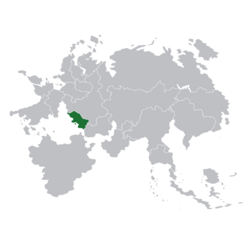Abramea: Difference between revisions
No edit summary |
|||
| Line 148: | Line 148: | ||
==Economics== | ==Economics== | ||
==Demographics== | ==Demographics== | ||
===Ethnic groups=== | |||
===Religion=== | |||
===Languages=== | |||
{{wp|Hebrew language|Abramean}} is the sole official language in Abramea, and is by far the most widely spoken. It is also considered the {{wp|national language}}. There are a number of smaller minority languages spoken in the country, primarily {{wp|Arabic language|Ashiri}} and {{wp|Neo-Aramaic_languages|Calcidian}}, which have varrying levels of recognition across the country. Historically, {{wp|Portuguese language|Lavarian}} was widely-spoken and the ''de facto'' language of instruction and business in the country; since independence, usage of Lavarian has declined dramatically, in part due to it being officially discourged by the government. It remains a {{wp|prestige language}} in the country regardless, and alongside {{wp|Uzbek language|Kodeshi}} is often taught as a secondary language in the education system. | |||
==Culture== | ==Culture== | ||
Revision as of 22:19, 27 July 2021
Union of Abramea האיחוד של אברם Ikhúd shel Avram | |
|---|---|
|
Flag | |
| Motto: "???" ("???") | |
| Anthem: ??? ("???") | |
 location of Abramea (green) | |
| Capital and largest city | Jerach |
| Official languages | Abramean |
| Recognised regional languages | Ashiri Calcidian |
| Demonym(s) | Abramean |
| Government | Unitary socialist kibbutz republic under a socialist democracy |
| Shimon ben-Yaakov | |
| Levana bat-Meshulam | |
| Legislature | General Sanhedrin |
| Independence from Lavaria | |
• Declared | 1928 |
• Recognised | 1933 |
| Population | |
• 2020 estimate | |
| GDP (PPP) | estimate |
• Total | 1.464 trillion |
• Per capita | 38,239 |
| GDP (nominal) | estimate |
• Total | 761.842 billion |
• Per capita | 19,904 |
| HDI | very high |
| Driving side | left |
| Internet TLD | .ab |
Abramea (Abramean: אברם, tr. Avram), officially the Union of Abramea (Abramean: האיחוד של אברם, tr. Ikhúd shel Avram), is a socialist state in Pamira. The country stretches from the Endotheric Sea to the Red Desert, bordering Uris to the south and sharing a maritime boundary with Lavaria to the west. Abramea has a population of 38.3 million, 71.3% of which lives close to the coast. The historic city of Jerach is the capital and largest city.
Humans first arrived in Abramea in around 90,000 years ago. A number of Abro-Ashiran peoples emerged in the region, and established city kingdoms during the Bronze Age; by the Iron Age, the territory had been largely united under the rule of the Kingdom of Jerach. This ancient kingdom became a client of the Cambran Empire around 10 BCE, and was fully subjugated by the Cambrans in 74 CE. When the empire was partitioned in 326, Abramea was put under the control of the Triumvirate of Appira. The Triumvirate relied on the support of local petty kings, who emerged as largely autonomous, and by 407 the Triumvirate had lost all authority in the region. A number of feudal realms emerged across the country, emulating the situation during antiquity.
The region was then subjugated by the Chaghanid Empire in ????. After the splintering of Zengui's empire in 1285, Abramea was largely part of the Zenguid Khanate, before eventually becoming part of the Gurkhanate. It remained part of the Gurkhanate until 1861, when the Jerach Crisis and subsequent Lavarian-Chaghanid War saw Jerach and the lion's share of the country transferred to Lavaria as a colony. The country was subject to attempts at Lavarianisation, and saw sizable migration from the Lavarian metropole. After the Great War, there were many calls for independence from Lavaria, but the government instead attempted to integrate Abramea into the country at large. Opposition to this, led by the labour movement and socialist leaders in Abramea, resulted in the Abramean Revolutionary War and the country's declaration of independence in 1928. Abramea was established as a socialist state, and was immediately recognised by the Pamiran Federation. Abramea's independence was recognised internationally in 1933, after the war came to a conclusion.
post-indy history
Abramea is a regional power in West Pamira, with among the largest economy in the region that has historically focused on oil extraction and pasturing, but has recently shifted to telecommunications, manufacturing, information technology and services. Abramea has a very high ranking on HDI, but is considered a middle-income country. The Union does maintain a good standard of living relative to its neighbours, with a welfare state and good education system. It is a unitary socialist state, which has been defined as both a kibbutz republic and a socialist democracy. Abramea is a member of the AN and the Jerach Pact.
Etymology
History
Geography
Government and politics
Economics
Demographics
Ethnic groups
Religion
Languages
Abramean is the sole official language in Abramea, and is by far the most widely spoken. It is also considered the national language. There are a number of smaller minority languages spoken in the country, primarily Ashiri and Calcidian, which have varrying levels of recognition across the country. Historically, Lavarian was widely-spoken and the de facto language of instruction and business in the country; since independence, usage of Lavarian has declined dramatically, in part due to it being officially discourged by the government. It remains a prestige language in the country regardless, and alongside Kodeshi is often taught as a secondary language in the education system.
